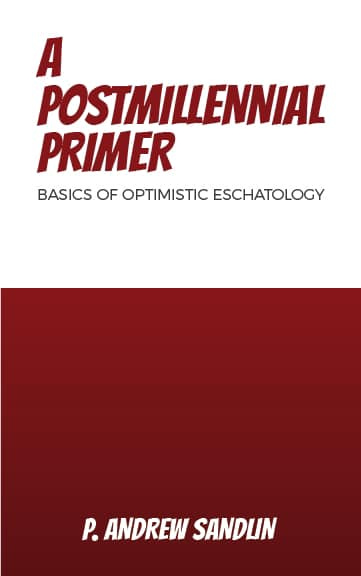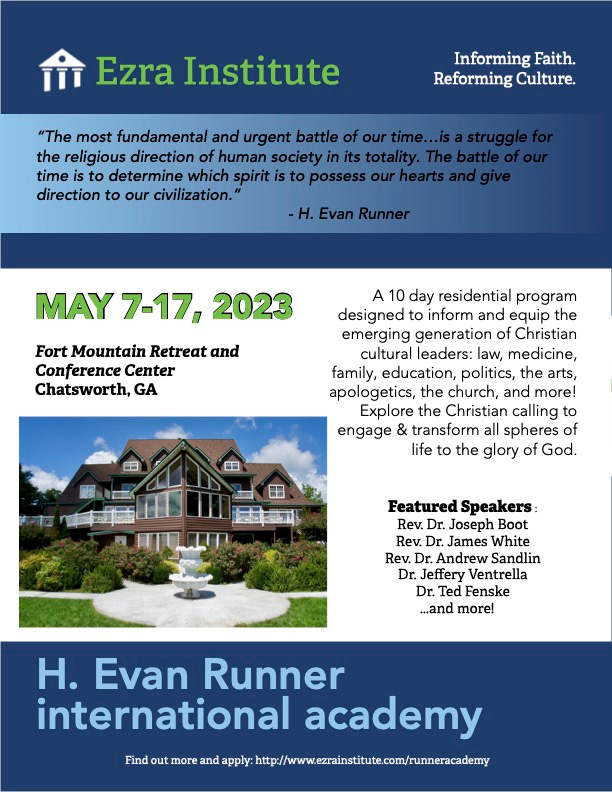A Victorious Pre-Parousia Eschatology
Christianity is at a low tide in the West, but the high tide will return in God’s good time. That irrepressible tide will eventually sweep away all opposition possible before the Second Advent.
Dear friends and supporters:
I’ve been thinking about eschatology lately (eschatology is the study of future events), and exposing eschatological heresy. I naturally thought of the books that were formative in my own eschatology, which is orthodox postmillennialism. (CCL will soon publish a revised, expanded version of my A Postmillennial Primer.)
One book that has majorly influenced me is J. Marcellus Kik’s 1971 Eschatology of Victory. Kik was a partial preterist postmillennialist (a mouthful, yes). He believed that NT passages predicting the near coming of the Lord referred to his judgment-coming in A. D. 70 on Jerusalem, while those pledging his distant, physical coming denoted what we term the Second Coming (or Advent). Kik believed that the Greek word parousia (pronunciation here) usually translated “coming” referred to the Second Coming, not the A. D. 70 judgment-coming. He believed the latter coming paved the way for great gospel success and Christian culture prior to the former, Second Coming.
His book consists of two parts. The first part is a short series of popular lectures at Westminster Seminary on the history of Reformed eschatology, which he judged to be mostly postmillennialism. This can be shown from Matthew 24 (Jesus’ Olivet Discourse) and Revelation 20 (where John mentions “thousand years” six times). Kik suggests it was the Dutch Reformed biblical theologian Gerhardus Vos that introduced what we call amillennialism into the Reformed camp.
The second, longer part of his book is a non-technical but thoughtful exegesis of both Matthew 24 and the relevant (“millennial”) portion of Revelation 20.
I’ll enumerate a few of his chief cogent points on only Matthew 24.
The Two Comings
Kik argues (like others) that Matthew 24 is divided into to main parts. Part 1 (vv. 4–35) deals with the impending destruction of Jerusalem by the Roman army in about A. D. 70. Part 2 (vv. 36–51) describes the distant Second Advent (so does chapter 25). Both are comings, the first past to us and the second ushering in history’s end.
Speaking to his disciples, Jesus had just predicted the destruction of the temple (vv. 1–2). This revelation seemingly disturbed them:
Now as He sat on the Mount of Olives, the disciples came to Him privately, saying, “Tell us, when will these things be? And what will be the sign of Your coming, and of the end of the age?” (v. 3)
His disciples thought they were asking one question, Kik postulates, but Jesus knew they were asking two. They couldn’t imagine a world devoid of the Jewish temple. The temple (and its wilderness predecessor, the tabernacle) signified God’s localized presence in the world. Its center was the Jewish nation, God’s covenant people. While God is omnipresent, he had condescended to dwell locally among the Jews in Solomon’s (and later the rebuilt) temple. Without the temple, the world just couldn’t go on since that would mean God himself had departed. The temple must survive until the Second Advent, which they knew would be the beginning of the end of human history.
Jesus the Temple
Jesus subverted their expectations by suggesting God is departing from the temple in the person of his Son, leaving it desolate (Mt. 23:37–39). It is from that time their temple, not his (Mt. 23:38). When Jesus abandoned the temple, God abandoned apostate Judaism.
In short, the godly world can go on only if the Jewish temple does not. God abandons apostate Judaism and turns to the Gentile nations, believers within whom become the New Israel (Rom. 2:28–29; 9:6–13; 24–29). Luke’s account in Acts chronicles this transition from Messiah-rejecting Jews to Messiah-inviting Gentiles. After the great A. D. 70 judgment-coming (Mt. 24:29), God’s great global work will commence:
Then the sign of the Son of Man will appear in heaven, and then all the [Jewish] tribes of the earth will mourn, and they will see the Son of Man coming on the clouds of heaven with power and great glory. And He will send His angels with a great sound of a trumpet, and they will gather together His elect from the four winds, from one end of heaven to the other. (Mt. 24:30–31)
The Judgment-Sign of the Coming
Kik believes this doesn’t denote the Second Advent, since the sign is not Christ himself but his judgment: the Romans destroying Jerusalem is the sign of the judging, ruling Lord.
“Coming on the clouds” is OT metaphorical language for God’s judgment (Is. 19:1; Ps. 97:2, 3; 104:3). Jesus isn’t claiming he’ll return to earth in A. D. 70, but that his coming in Rome’s horrific decimation of Judaism is a sign of his righteous rule in the heavens.
Birth Pangs of Gospel Victory
The subsequent gathering of the elect isn’t the Second Coming, but his bringing together his elect global, multinational church made possible by the decimation of apostate Judaism and its temple. This is judgment paving the way for global grace and victory.
This is why Jesus declares in verse 8, “All these [the horrific tribulations of A. D. 70] are the beginning of sorrows [or birth pangs].” Just as the tribulation of childbirth heralds the joy of a new baby, so the tribulation of A. D. 70 heralds the joy of worldwide gospel preaching and victory.
Hindering Gospel Success
Nor does this mean that from A. D. 33 to 70 the Great Commission wasn’t launched. In fact, Jesus predicts as much in verse 14 —
And this gospel of the kingdom will be preached in all the world as a witness to all the nations, and then the end will come.
This isn’t referring to our own times, or just before the Second Advent, but to the times preceding the A. D. 70 judgment-coming. At Pentecost the gospel was proclaimed to “every nation which is under heaven” (Ac. 2:5). Paul tells the Roman church that their faith is spoken of throughout the entire world (Rom. 1: 8). He writes in Colossians 1:6, 23 that the gospel had reached the entire world and had been “preached to every creature which is under heaven.” The gospel had penetrated the known first-century world, thereby fulfilling our Lord’s prophecy.
Will you consider a tax-deductible donation to CCL via PayPal or Venmo? Or mail a check to CCL, Box 100, Coulterville, CA 95311. God uses you to keep us going — and expanding.
But this gospel proclamation wasn’t sufficient. Jesus commissioned his apostles to disciple the nations (Mt. 28:18–28). One major barrier stood in the way of this global success. The destruction of the temple and the end of Judaism it accomplished and signified were necessary to the global success of the gospel.
In other words, the Great Commission couldn’t be fully fulfilled as long as the Jewish temple remained standing. Christianity is a global religion (and was always intended to be a global religion), and Jewish exclusivity stood in its way. Therefore, the temple and Judaism had to go.
The Two Worlds
When we come to verse 36, however, we encounter an entirely different situation from the A. D. 70 judgment-coming. Jesus states:
“But of that day and hour no one knows, not even the angels of heaven, but My Father only.”
Kik observes “[t]hat day and hour” is language with which the disciples would have been familiar (Mt. 7:22; 11:20, 24; 12:36). It is the day of final judgment, final reckoning, the final advent at history’s end. No one knows that “day and hour,” not even our Lord himself in his pre-resurrection economy. Understand that Jesus most surely knew when the days of his judgment-coming would be, since he had just predicted when they would be. He knew the timing of his judgment-coming, but not his final coming, the parousia.
The A. D. 70 judgment-coming of vv. 4–29 could be reliably dated by the preceding horrors, all of which did in fact happen. Readers who don’t account for the OT might interpret statements like the sun and moon’s darkening and the stars falling as a massive cosmic, future conflagration, but they’re actually a past, covenantal conflagration. This is the precise OT covenant language for God’s judgment (Is. 13:10; 34:4, 5; Ezek. 32:7, 8; Joel 2:28–32). This language signifies God’s covenant judgment since its horror is so thick that it can be compared to the blotting out of the heavenly bodies. It conveys Christ’s coming in final destruction of Israel.
No Precursors of the Parousia
Yet the parousia of v. 32f. has no precursors whatsoever. In fact, Jesus declares pointedly that those living at the time will not know when this coming will occur. The entire picture is one of uniform normality:
But as the days of Noah were, so also will the coming of the Son of Man be. For as in the days before the flood, they were eating and drinking, marrying and giving in marriage, until the day that Noah entered the ark, and did not know until the flood came and took them all away, so also will the coming of the Son of Man be. Then two men will be in the field: one will be taken and the other left. Two women will be grinding at the mill: one will be taken and the other left. Watch therefore, for you do not know what hour your Lord is coming. But know this, that if the master of the house had known what hour the thief would come, he would have watched and not allowed his house to be broken into. Therefore you also be ready, for the Son of Man is coming at an hour you do not expect. (vv. 37–44)
This bucolic scene disrupted by the parousia is hardly a picture of the horrific conflagration of verses 15–30! The parousia will be sudden; swift; and for unbelievers, unanticipated. This is emphatically not the case with the A. D. 70 judgment-coming. It was torturously grueling, and believers had time to (and in fact did) escape it (Mt. 24:16-18).
This is not true of the immediate pre-parousia world. The Great Commission has been fulfilled; there is great domestic tranquility; and the world is one of relative calm, peace, and routine, “eating and drinking, marrying and giving in marriage.” But there will still be unbelievers, and they will be overtaken as by an unanticipated night-thief.
This is a picture of a calm world not under judgment but prepared for the Final Judgment of the righteous and unrighteous (Mt. 25:31ff.) following the parousia.
The Barren Versus Flourishing Fig Tree
In Matthew 21:18–19, Jesus cursed a barren fig tree. Just afterward in the Olivet Discourse he used a fruitful fig tree as proof of the nearness of his judgment-coming soon after his ascension. These signs of impending destruction are also the indication of as subsequent flourishing, a great gospel harvest. To compare the earlier metaphor, they are the birth pains heralding an impending thriving life.
The Great Delay
But the parousia (Second Advent) will occur much later, so much later that his impatient servants will claim “My master is delaying his coming” (Mt. 24:48). To hammer home the point, Jesus uttered the Matthew 25 parables of the wise and foolish virgins and of the talents, which stress the “delay” (v. 5) of the Lord’s coming, and describe it as happening after “a long time” (v. 19). This refutes the idea of a future Great Tribulation Period (which actually was the A. D. 70 judgment, Kik argues) and the popular idea that the world will grow increasingly apostate before the Second Advent.
Rather, the A. D. 70 judgment-coming swept away the apostate Jewish nation and the obsolete old covenant barrier that stood in the way of the great global success of the gospel.
Conclusion
An Eschatology of Victory lays out a biblical case for the pre-parousia success of the gospel and founding of worldwide Christian culture. And historically that’s precisely what happened in the West and even parts of the Middle East, Asia and Africa. Christianity is at a low tide in the West, but the high tide will return in God’s good time.
And it will be the final pre-parousia tide.1 That irrepressible tide will eventually sweep away all opposition possible before the Second Advent: “[T]he earth will be filled [w]ith the knowledge of the glory of the Lord, [a]s the waters cover the sea” (Hab. 2:14).
Yours for our victorious King and his Kingdom,
Founder & President, Center for Cultural Leadership
Join Me at the H. Evan Runner International Academy
Register here.
Tweet of the week
More great stuff:
The Center for Cultural Leadership site is here.
My Amazon author page (print and digital) is here.
My I-Tunes sermons, lectures and podcasts are here.
You can find my sermons and lectures at my YouTube channel.
Sign up to get my blog updates here.
Here’s my Twitter feed.
If you want to get the free exclusive hard copy publication Christian Culture, please send me a Facebook private message.
The CCL phone number is 831-420-7230.
The mailing address is:
Center for Cultural Leadership
P. O. Box 100
Coulterville, CA 95311
There will be a final, short-lived, Satanically instigated rebellion just preceding the Second Advent, extinguished by the Lord’s physical judgment-presence (Revelation 20:7–10).









Great article!
Thank you and may the Lord bless this work you are doing. It is an encouragement.